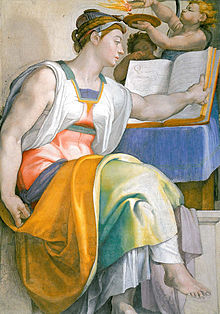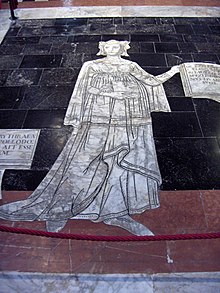Sibyl of Erythrai

The Erythraeische Sibylle is one of the according to Varro , a Roman historian of the 1st century BC. BC , ten sibyls differentiated from lactance , each provided with a geographical epithet .
In the following, she is understood as the seer from Erythrai on the Ionian coast, who is said to have prophesied the fall of Troy . In addition to the Tiburtine Sibyl , she was the most famous pagan seer among scholars and the people in the Middle Ages . "Ancient" warnings about a "world judgment" ( apocalypse ) were ascribed to it.
According to ancient legend, the place of the oracle of the Erythrean Sibyl was Erythrai in Asia Minor. With the exception of Tacitus previously, there is hardly any direct reference to a Sibyl especially at this location in other extant sources from ancient Greece and Rome .
Following Augustine Christian understood Middle Ages the Erythraean Sibyl than the prophet gleichzustellende Pagan herald an ordeal ( Revelation ). This view was based in particular on a " quote " with this sibyl ascribed to apocalyptic words that can be found in this 4th century church doctor. In the Renaissance , on the other hand, its generally accepted prophetic expectation of God was emphasized.
In Gothic art , the Erythrean Sibyl is often represented as one in a series of sibyls , based on the Varro listing , often together with an often equal number of prophets from the Old Testament. In the numerous group depictions of Sibyls there is almost always an Erythrean Sibyl named by name or it can be recognized by a banner or book pages with parts of the quotation ascribed to her. Representations of a single sibyl in the Gothic, especially in the context of scenes of the Last Judgment, are often interpreted as an Erythrean Sibyl , especially since their "words" had an influence on the structure and understanding of the funeral mass at this time and also their figure (usually the only one of the Sibyls) appeared in popular religious games .
The Renaissance put the apocalyptic character of this sibyl in the background and emphasized more generally her “ prophethood ”. Your most famous pictorial representation today, not only from this era, is the Erythrae among the five Sibyls of Michelangelo in the fresco on the ceiling of the Sistine Chapel .
Among numerous representations of the Erythraean Sibyl , one finds them in the following places:
- near Capua a Romanesque fresco in the church of Sant'Angelo in Formis , near a scene of the Last Judgment;
- In the cathedral of Siena , a floor mosaic shows a cycle of images of various sibyls, including the Erythraean.
Among the ten Gothic half-sculptures in the choir stalls of the Ulm Minster , none of the Sibyls is directly referred to as the Erythraean Sibyl , but the entire text of their words can be found there as a panel.
See also
Web links
Individual evidence
- ^ Des Lucius Caelius Firmianus Lactantius writings . Translated from Latin by Aloys Hartl. (Library of the Church Fathers, 1st row, Volume 36) Munich 1919. Chapter 5
- ^ Sibylle in: Microsoft Encarta
- ^ Tacitus: Annalen , XII, 6
- ↑ Augustine, God's State, Book 18, Chapter 23
- ↑ cf. Wilhelm Vöge : Jörg Syrlin the Elder and his sculptures, Vol. II: Circle of material and design . Publisher: Dt. Association f. Kunstwiss., Berlin 1950, without ISBN
